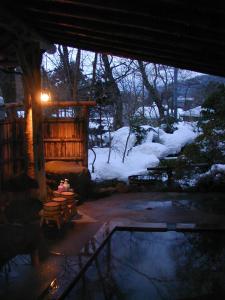Onsen
Natural hot springs (温泉, onsen) are numerous and highly popular across Japan. Every region of the country has its share of hot springs and resort towns, which come with them.
There are many types of hot springs, distinguished by the minerals dissolved in the water. Different minerals provide different health benefits, and all hot springs are supposed to have a relaxing effect on your body and mind. Hot spring baths come in many varieties, indoors and outdoors, gender separated and mixed, developed and undeveloped. Many hot spring baths belong to a ryokan, while others are public bath houses. An overnight stay at a hot spring ryokan is a highly recommended experience to any visitor of Japan.
Mixed bathing
Traditionally, men and women bathed together at the onsen and sentō but gender separation has been enforced since the opening of Japan to the West during the Meiji Restoration. Mixed bathing (混浴 konyoku?) persists at some special onsen in rural areas of Japan,[2] which usually also provide the option of separate "women-only" baths or different hours for the two sexes. Men usually cover their genitals with a small towel while bathing, while women usually wrap their bodies in full size towels. Children of either sex may be seen in both the men's and the women's baths. In some prefectures of Japan, including Tokyo, where nude mixed bathing is banned, people are obligated to wear swimsuits or yugi (湯着 yugi?), which are specialized clothing for baths.

Etiquette
===Ensuring cleanliness At an onsen, as at a sentō, everyone are expected to wash their bodies and rinse themselves thoroughly before entering the hot water. Bathing stations are equipped with stools, faucets, wooden buckets, and toiletries such as shampoo and bodybash; nearly all onsen also provide removable shower heads for bathing convenience. Entering the onsen while still dirty or with traces of soap on the body or shampoo in hair is socially unacceptable
Swimsuits
Usually people are not normally allowed to wear swimsuits in the baths. However, some modern onsen with more of a waterpark atmosphere require their guests to wear a swimming suit in their unisex baths.
Towels
Onsen bathers generally bring a small towel with them to use as a wash cloth. The towel can also provide a modicum of modesty when walking between the washing area and the baths. Some onsen allow one to wear the towel into the baths, while others have posted signs banning this, saying that it makes it harder to clean the bath. It is sometimes against the rules to immerse or dip towels in the onsen bath water, since this can be considered un-clean. In this latter case, people normally set their towels off to the side of the water when enjoying the baths, or place their folded towels on top of their heads.
Noise
Onsen vary from quiet to noisy, some play piped music and often feature gushing fountains. Bathers will engage in conversation in this relaxed situation. There are usually prohibitions against rowdiness in the washing and bathing areas.
Tattoos
Around half (56%) of onsen operators ban bathers with tattoos from using their facilities. The original reason for the tattoo ban was to keep out Yakuza and members of other crime gangs who traditionally have elaborate full-body decoration. Tattoo-friendly onsen do exist. A study by the Japan National Tourism Organisation found that more than 30% of onsen operators at hotels and inns across the country will not turn someone with a tattoo away; another 13% said they would grant access to a tattooed guest under certain conditions, such as having the tattoo covered up. With the increase in foreign customers due to growing tourism, some onsens that previously banned tattoos are loosening their rules to allow guests with small tattoos to enter, provided they cover their tattoos with a patch or sticking plaster.
See Also
- North America | South America | Europe | Africa | Asia | Oceania

